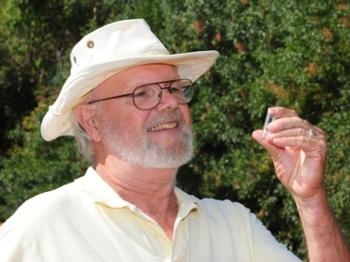
Honey bees, yes! Bumble bees, yes! Carpenter bees, uhh, not so much.
Ever seen carpenter bees drilling holes in dead limbs or untreated fence posts to build their nests? No? Well, you've probably seen them in their "robber role," piercing a hole in the corolla of a flower and robbing the nectar, bypassing pollination.
"Beneficial insects or pests?" we asked native pollinator specialist Robbin Thorp, distinguished emeritus of entomology at the University of California, Davis.
"Carpenter bees are controversial and their status as pests or beneficial insects is complicated," Thorp noted. "Some people consider only the negative effects of carpenter bee behaviors--tunneling in wood structures we create or nectar-robbing from some long-tubed flowers--deeming them pests and seeking ways to control them.
"But carpenter bees are important pollinators in native plant communities, and even beneficial as pollinators of some crop plants such as passion fruit, blueberries, melons, hybrid cotton and they are effective buzz pollinators of tomatoes and egg plant," he said. "Even effects of their nectar robbing are not entirely negative. They may actually enhance out-crossing by forcing legitimate pollinators to visit more flowers thus increasing out-crossing. In some cases, they may actually pollinate flowers while nectar-robbing from them."
"Carpenter bee tunneling into wood is an initial step in breaking down dead limbs and logs as part of the recycling process in natural communities. It is when they burrow into untreated wood used in our constructions that they are considered pests."
Thorp said that "any damage caused by them should be weighed against their positive contributions in trying to determine whether to attempt to control them or not."
Bottom line: we consider carpenter bees beneficial.
California has three species of carpenter bees.
- The biggest is the Valley carpenter bee, Xylocopa varipuncta. It's about an inch long. The female is solid black, while the male, commonly known as "the teddy bear bee," is a green-eyed blond. Why teddy bear? It's fuzzy and does not sting--or as Thorp says "Boy bees don't sting."
- The second largest is the California carpenter bee or Western carpenter bee, Xylocopa californica, often found in the mountain foothill areas of northern and southern California. It's known for its distinctive distinctive bluish metallic reflections on the body, Thorp says. The females have dark smoky brown wings.??
- The smallest is the foothill or mountain carpenter bee, Xylocopa tabaniformis orpifex. The females are black with light smoky-colored wings. The male has bright yellow marks on the lower part of its face and some yellow hairs on the top front of its thorax.
Check out the images and descriptions of carpenter bees on BugGuide.net).
Want to hear more about California's bees, which total some 1600 species? Thorp will be giving a two-hour presentation, "Bee Aware Bee Cause," on Saturday, Jan. 7 starting at 1:30 at the Rush Ranch Nature Center, 3521 Grizzly Island Road, Suisun. The site is located off Highway 12, two miles south of Suisun City. The event, free and open to the public, is sponsored by the Rush Ranch Educational Council, in partnership with Solano Land Trust, owner of Rush Ranch.
Thorp, who holds a doctorate in entomology from UC Berkeley, taught entomology at UC Davis from 1964 to 1994. Although emeritus since 1994, he continues his research, writings, bee identification, public outreach and other "bee-involved" activities from his headquarters in the Harry H. Laidlaw Jr. Honey Bee Research Facility at UC Davis.
Thorp co-authored the UC California book, California Bees and Blooms: A Guide for Gardeners and Naturalists (Heyday) and Bumble Bees of North America: An Identification Guide (Princeton University Press). He annually teaches at The Bee Course (American Museum of Natural History), at the Southwestern Research Station, Portal, Ariz. The two-week course is offered for conservation biologists, pollination ecologists and other biologists who want to gain greater knowledge of the systematics and biology of bees.
Attached Images:
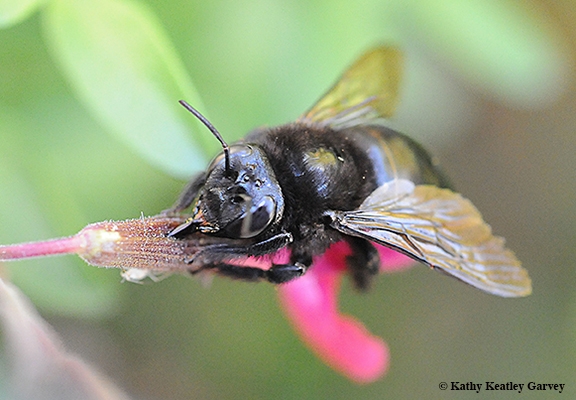
A female mountain carpenter bee, Xylocopa tabaniformis orpifex, pierces the corolla of salvia to rob the nectar. (Photo by Kathy Keatley Garvey)
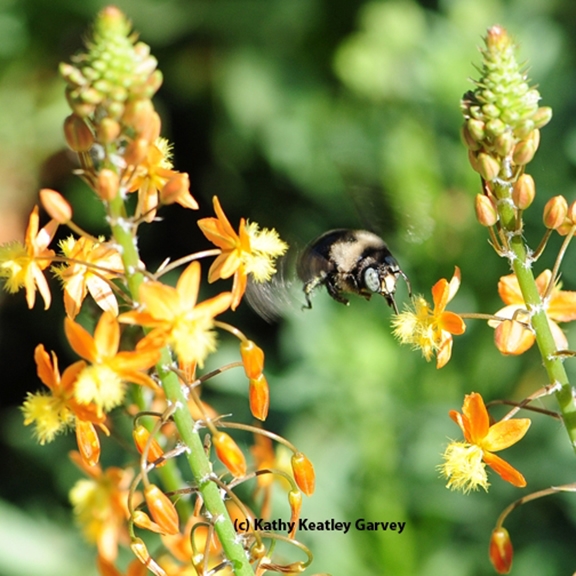
A male mountain carpenter bee, Xylocopa tabaniformis orpifex, heads for bulbine. (Photo by Kathy Keatley Garvey)
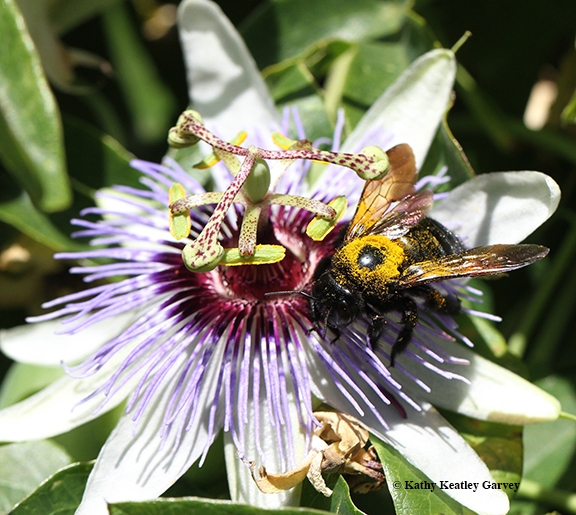
A familiar sight: a female Valley carpenter bee, covered with pollen and nectaring on a passion flower. The female is solid black, while the male of this species is a green-eyed blond. (Photo by Kathy Keatley Garvey)
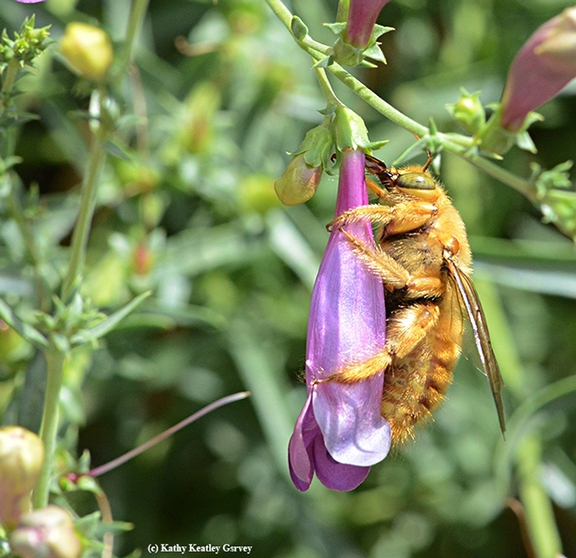
A male Valley carpenter bee, Xyclopa varipuncta, pierces the corolla of a foothill Penstemon. (Photo by Kathy Keatley Garvey)

Female carpenter bees, Xyclopa variuncta, often drill holes in limbs of dead trees to build their nests. This find, from Davis naturalist/photographer Allan Jones, shows a male wintering inside one of the holes. (Photo by Kathy Keatley Garvey)